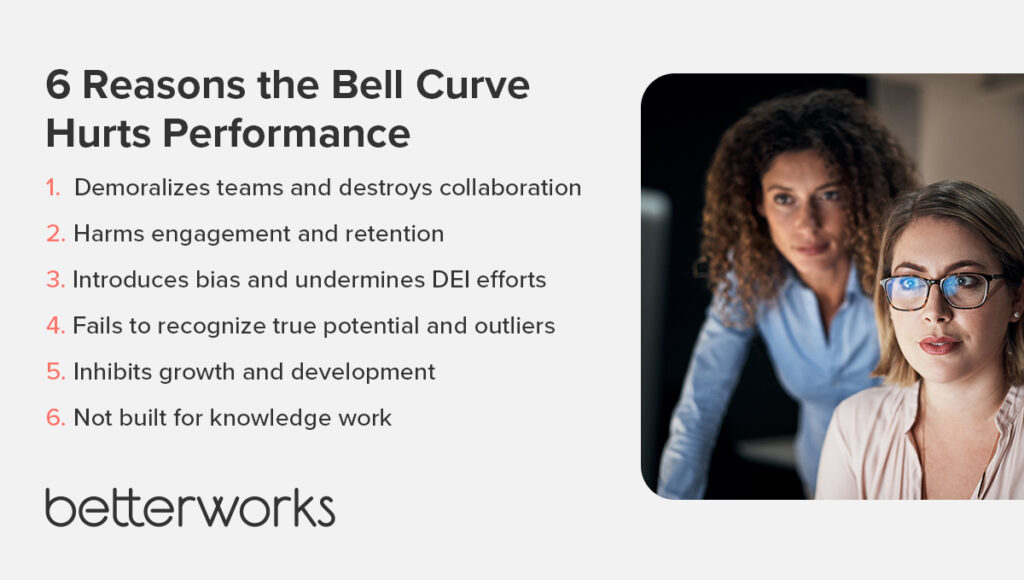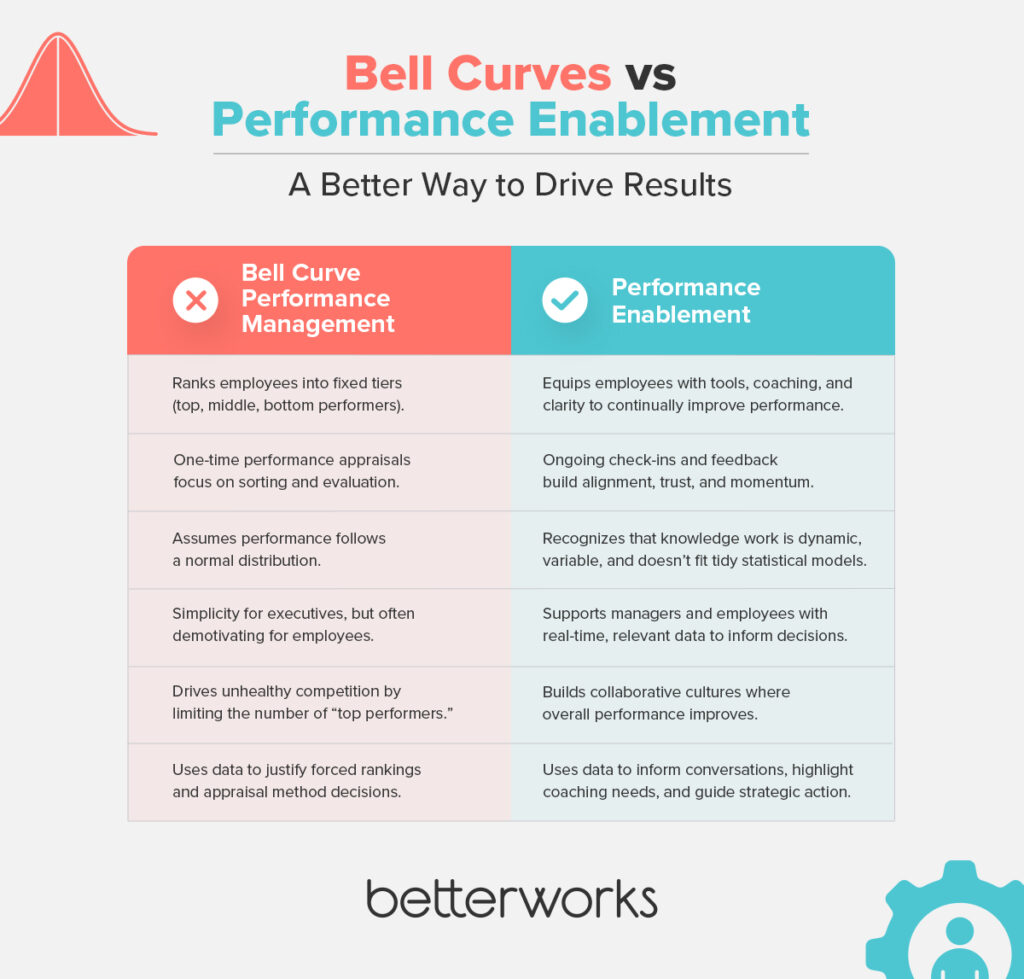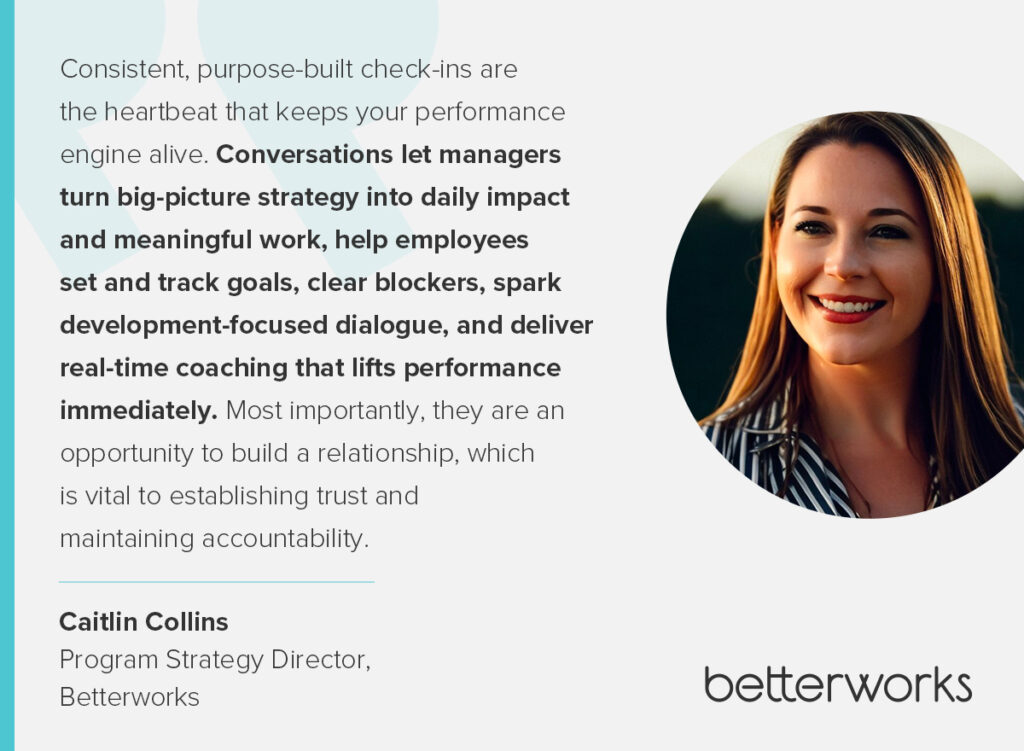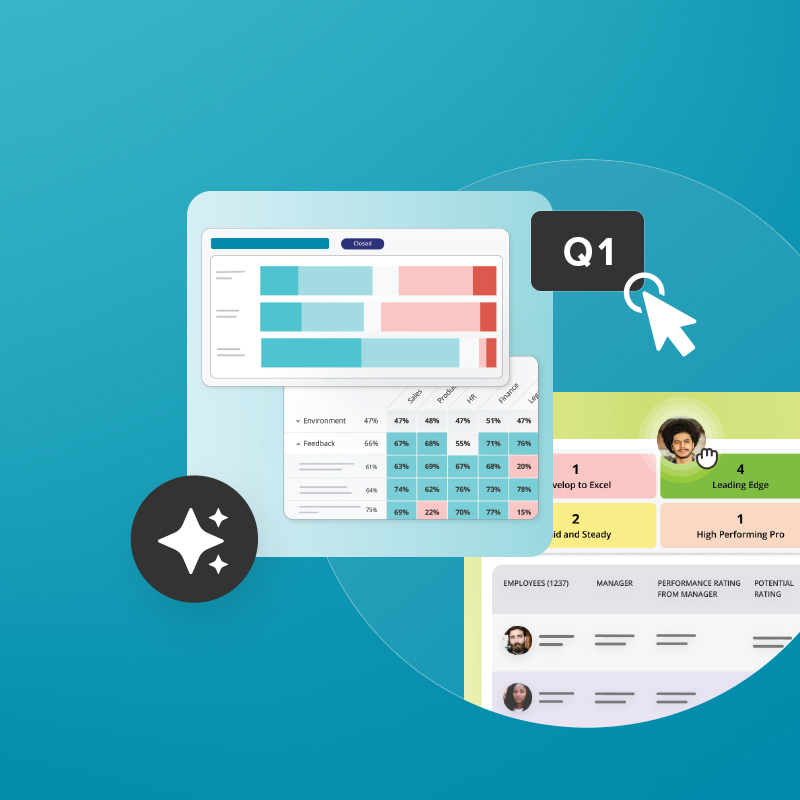- What is the performance management bell curve?
- Why organizations still cling to the bell curve
- 6 reasons the bell curve is bad for performance management
- Why performance enablement models outperform bell curves
- Rethinking performance management for a modern workforce
- Ready to transform your performance management program?
Even if your organization doesn’t call it “stack ranking” or use the phrase “bell curve,” chances are, some version of the performance management bell curve is still lurking in your performance review process.
Maybe it’s the expectation that only a small number of employees can be rated as top performers. Maybe it’s the pressure to fit a team’s results into a tidy, predetermined distribution. Whatever it’s called, the underlying mindset is the same: success is limited, and performance must be sorted.
This model may have made sense in an earlier era of work that was built on rigid hierarchies, individual output, and static roles. But for today’s agile, collaborative, and knowledge-driven teams, it’s increasingly out of place. The use of bell curve in performance management doesn’t just fail to reflect how modern work gets done. It actively undermines the kind of culture and performance most organizations are trying to build.
What is the performance management bell curve?
The performance management bell curve is a framework that sorts employee performance into a fixed distribution — typically 20% high performers, 70% average, and 10% low performers. Often referred to as forced ranking, stack ranking, or the vitality curve, this model became widely known through Jack Welch’s use of the 20-70-10 rule at General Electric.
This approach is rooted in the statistical concept of the normal distribution, a probability distribution in which most values cluster near the mean, with fewer appearing at the extremes. This pattern, often referred to as a bell curve due to its distinctive shape, is commonly used to model natural variation in large populations.
When applied to employee performance, the model gives organizational leaders a structure to:
- Reward top talent (the right-hand tail of the curve) to keep them engaged
- Motivate the majority (the middle) to maintain or improve performance
- Weed out underperformers (the left-hand tail) to create space for stronger contributors
During the 1980s and 1990s, this model gained popularity among large organizations seeking to formalize performance reviews and drive accountability by ranking employees in clearly defined performance tiers. However, its use has since declined in many companies due to concerns over fairness, collaboration, and the limits of rigid categorization.
Why organizations still cling to the bell curve
The perceived advantages of the bell curve in performance management continue to make it appealing in many organizations.
Habit
In many organizations, the bell curve method persists because it’s embedded in longstanding systems and practices. It offers a known structure that’s easy to repeat.
Perceived objectivity
Structured distributions are often seen as a way to apply consistent standards across teams. By assigning performance ratings to a fixed curve, some organizations aim to reduce bias and standardize performance evaluation results.
Accountability framework
The model provides a built-in mechanism for identifying top and low performers, which can support more easily defensible compensation and promotion decisions.
Simplicity and scalability
The bell curve offers a high-level summary of performance levels that’s easy to digest and replicate, especially useful for organizations managing a large number of employees.

6 reasons the bell curve is bad for performance management
While the bell curve system may appeal to executives for its structure and simplicity, that perspective often diverges from how employees experience performance management.
The Betterworks 2024 Performance Enablement Report found that while 88% of executives and HR leaders rate their approach as successful, only 56% of individual contributors agree. It’s a clear signal that what works in theory can fall flat in practice, especially for the people that performance management is meant to support. And when you look closely at how the bell curve plays out in real organizations, the problems start to stack up.
Demoralizes teams and destroys collaboration
Competition replaces collaboration when only a few can be rated as top performers. People are incentivized to hoard ideas rather than share them. Psychological safety suffers, and unhealthy competition takes root.
Harms engagement and retention
Bell curves trap employees in fixed categories. When people can’t grow past their labels, disengagement sets in. Hidden high performers often exit rather than wait for their turn. Those labeled underperformers get placed on “performance improvement plans” that generally lead to anything but.
Introduces bias and undermines DEI efforts
Forced rankings push managers into arbitrary decisions. Remote workers and less-visible contributors are often penalized. Sparse or subjective data reinforces inequities.
Fails to recognize true potential and outliers
Innovators and outliers are flattened into “averages.” Nontraditional strengths are overlooked in favor of conformity, and performer distributions become misleading.
Inhibits growth and development
Mid-performers get neglected. Some managers game the system, rotating high ratings to avoid hard conversations, a tactic that erodes trust. This flaw in the appraisal method can stifle development.
Not built for knowledge work
Knowledge work is collaborative, variable, and highly context-dependent. People working in these types of roles don’t fit in such rigid boxes. Their work is shaped by evolving priorities, dynamic roles, and team interdependence. Trying to rank that complexity into fixed categories strips away nuance and insight from overall performance assessments and performance management processes.

Why performance enablement models outperform bell curves
Most people come into their roles wanting to succeed. A modern performance system should help them do just that. The goal should not be to sort people into static categories, but to push the bell curve to the right. That’s the promise of continuous performance enablement. Here’s why it’s so much more effective.
Require regular check-ins
One-and-done reviews don’t cut it anymore. Today’s teams need real-time input, not annual verdicts. Regular, structured check-ins between managers and employees create space for timely recognition, constructive course-correction, and open dialogue. They build the trust and clarity employees need to stay aligned and engaged.
“Consistent, purpose-built check-ins are the heartbeat that keeps your performance engine alive,” says Caitlin Collins, program strategy director at Betterworks. “Conversations let managers turn big-picture strategy into daily impact and meaningful work, help employees set and track goals, clear blockers, spark development-focused dialogue, and deliver real-time coaching that lifts performance immediately. Most importantly, they are an opportunity to build a relationship, which is vital to establishing trust and maintaining accountability.”
Facilitate agile goal setting
Goals should be more than a checkbox exercise. They should clarify priorities in changing market conditions, fuel high performance and make progress visible. They can replace the backward-looking documentation of traditional review cycles with transparent, measurable expectations that scale across teams and levels.
Support development-focused conversations
Great performance requires support, not just judgment. Managers need the tools and training to have forward-looking conversations that address progress, identify blockers, and build skills. When these conversations are embedded in the flow of work and in a regular cadence, they reinforce a culture of enablement and unlock individual potential.

Encourage informed, contextual feedback
Not all feedback is created equal. The most valuable insights come from the people closest to the work: peers, partners, project leads. Capturing feedback in context makes it more relevant and actionable, and less about checking boxes. It also removes the performative layer of 360 reviews and keeps the focus where it belongs: on helping employees improve.
Facilitate ethical interpretation of people data
Data should support decisions, not dictate them. Modern performance systems use aggregated data from goals, check-ins, and feedback to identify trends, highlight coaching opportunities, and flag engagement risks. This kind of intelligence empowers HR and leadership to act thoughtfully without resorting to forced distributions or quotas.
Rethinking performance management for a modern workforce
Performance management isn’t about identifying winners and losers. It’s about enabling every employee to do their best work and giving managers the tools to help them get there. The distribution curve in performance appraisal models doesn’t reflect the reality of today’s teams. It never really did.
Betterworks helps organizations move beyond forced rankings with performance tools built for growth and agility. The platform supports flexible goal-setting, structured conversations, and calibration tools that adapt to your organization’s unique needs by enabling fair, consistent assessments without resorting to quotas or rigid distributions. It encourages ongoing feedback, prioritizes development, and helps make performance a shared, strategic focus across the business.
Ready to transform your performance management program?
Discover how Betterworks’ integrated platform empowers organizations to move beyond outdated models, fostering a culture of continuous performance, strategic goal-setting with OKRs, and meaningful coaching conversations. Explore our solutions and then reach out to talk to an expert.
Drive high performing teams with continuous performance management




